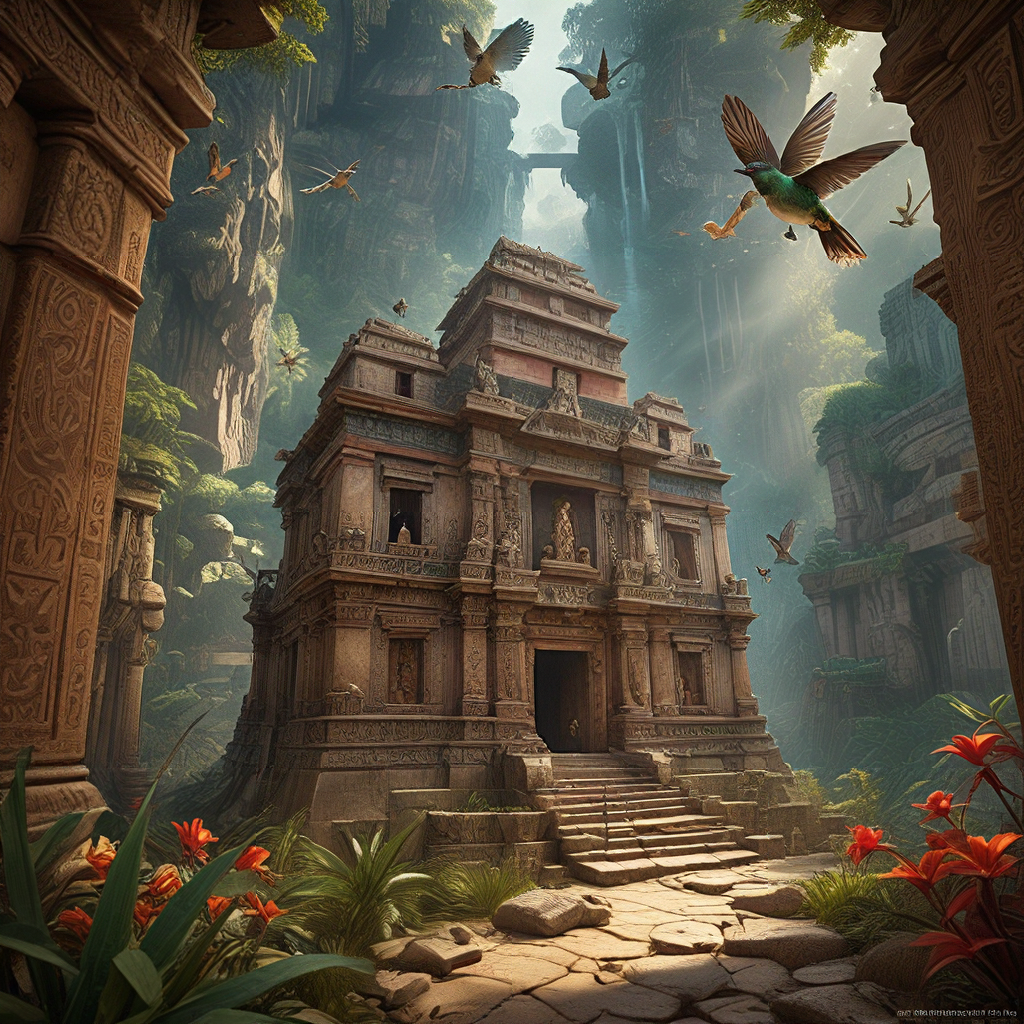The Legend of the Temple of the Hummingbird
The Incan Empire, a civilization that flourished in the Andes Mountains of South America, left behind a rich tapestry of myths, legends, and stories. Among these tales, the Temple of the Hummingbird stands out as a captivating enigma, a place shrouded in mystery and intrigue. This temple, according to legend, was the keeper of secrets, a sacred sanctuary where the Incas believed their most profound wisdom and knowledge were protected.
The story of the Temple of the Hummingbird whispers of a hidden location, a sanctuary built to honor the hummingbird, a creature revered by the Incas for its beauty, agility, and connection to the divine. The temple, it is said, was dedicated to this majestic bird, its walls adorned with intricately carved hummingbirds, their wings seemingly in perpetual motion, echoing the enduring spirit of the Incan civilization.
The Hummingbird as a Sacred Symbol
In Incan mythology, the hummingbird held a profound significance, representing the essence of life, the power of transformation, and the connection between the earthly and the celestial realms. The bird's ability to hover effortlessly in mid-air and its rapid, almost magical, flight patterns symbolized the interconnectedness of all things. They were believed to be messengers, capable of traveling between different dimensions, carrying messages from the spirit world to the mortal realm.
The Incas saw the hummingbird as a symbol of vitality and renewal, its vibrant colors mirroring the beauty and diversity of the natural world. It was believed to be an embodiment of the sun god Inti, a powerful deity who played a central role in Incan religion and culture. The hummingbird's connection to the sun god further reinforced its sacred status, making it an object of reverence and awe among the Incan people.
The Temple’s Location: A Mystery Shrouded in Myth
The precise location of the Temple of the Hummingbird remains a mystery, shrouded in time and veiled by the passage of centuries. The Incas, known for their meticulous record-keeping, left no detailed maps or written accounts pinpointing the temple's exact whereabouts. The stories of the temple, passed down through generations, speak of its hidden location, concealed from prying eyes within the labyrinthine Andes Mountains.
The temple, it is said, was tucked away in a secluded valley, surrounded by towering mountains and lush vegetation, hidden from view by the dense foliage and mists that often blanket the Andean highlands. Some believe that the temple was hidden deep within a cave, its entrance camouflaged by the natural surroundings, and only accessible through a secret passage known only to a select few. Others speculate that it may be located on a high peak, a vantage point from which the Incas could observe the celestial bodies and commune with the forces of nature.
The Sacred Secrets Guarded Within
The Temple of the Hummingbird, according to legend, was a repository of ancient wisdom and knowledge, a place where the Incas preserved their most prized secrets. These secrets, it is believed, encompassed a range of knowledge, including astronomy, astrology, medicine, and the art of war. The temple was said to hold intricate astronomical charts, detailing the cycles of the stars and planets, knowledge that helped the Incas track time and predict celestial events.
Within its chambers, it is believed, lay carefully crafted medicinal herbs and formulas, passed down through generations, used to heal the sick and alleviate suffering. The temple was also said to possess knowledge of warfare, strategies, and tactics that enabled the Incas to establish and maintain their vast empire. These secrets, passed down from generation to generation, were safeguarded within the temple, its walls embodying the Incan belief in the importance of preserving and transmitting knowledge to future generations.
The Role of the Temple in Incan Rituals
The Temple of the Hummingbird played a vital role in Incan religious ceremonies and rituals. The temple was believed to be a conduit between the human and the divine realms, a place where Incan priests and shamans could communicate with the spirits and seek guidance from the celestial beings.
The Incas gathered at the temple for festivals and celebrations, offering prayers and sacrifices to the gods. They performed intricate dances and rituals, seeking blessings for their crops, their communities, and their empire. The temple's sacred space offered a tangible connection to the supernatural, a place where the Incas could experience the presence of the divine and seek guidance and inspiration.
The Temple’s Connection to the Sun God Inti
The Temple of the Hummingbird was intricately linked to the Incan sun god, Inti. The hummingbird, with its vibrant colors and swift movements, was seen as a manifestation of Inti's power and energy. Inti was believed to be the source of life, warmth, and light, and the hummingbird, as his earthly representative, embodied these qualities.
The Incan people held deep reverence for Inti, believing him to be the creator of the world and the ruler of the heavens. They built elaborate temples to honor him and performed elaborate rituals to appease him. The Temple of the Hummingbird, with its deep connection to Inti, became a central location for Incan religious practices.
The temple served as a place where the Incas could connect with the divine, offering prayers and sacrifices to Inti, seeking his favor and protection. The temple's location, hidden within the mountains, was symbolic of Inti's power and mystery. The sun, rising over the peaks and casting its golden rays upon the temple, was a constant reminder of Inti's presence and influence.
Theories on the Temple’s Existence
While the Temple of the Hummingbird remains a mystery, there are different theories about its potential existence. Some scholars believe that the temple may have been a real structure, built by the Incas as a place of worship and knowledge. They point to the Incan legacy of constructing impressive temples, palaces, and fortresses throughout their empire, as evidence of their architectural skills.
Others, however, suggest that the temple might be a purely mythical construct, a symbolic representation of the Incan belief system and their connection to the natural world. The temple, in this interpretation, may not have been a physical structure but rather a spiritual concept, representing the sacred space within the natural world.
Still other scholars believe that the temple may have existed but was destroyed or lost over time. The Incan Empire fell in the 16th century, and many of their sacred places were destroyed or looted by the Spanish conquistadors. The temple, if it did exist, could have been buried under layers of debris or hidden by the passage of centuries.
The Possible Location of the Temple
The exact location of the Temple of the Hummingbird remains a subject of speculation and debate. Some believe that the temple may be hidden within the ruins of Machu Picchu, an ancient Incan city located in the Andes Mountains. Others suggest that it might be located in the Sacred Valley, a region renowned for its archaeological sites and stunning natural beauty.
There are also those who believe that the temple may be located elsewhere in the Andes Mountains, perhaps concealed within a cave or on a high peak, just as described in the legends. The search for the temple continues, fueled by the allure of its mystery and the potential for uncovering lost treasures and ancient knowledge.
The Temple’s Significance in Incan Culture
The Temple of the Hummingbird holds a significant place in Incan culture and mythology. It represents the Incan belief in the interconnectedness of all things, the reverence for nature, and the importance of preserving knowledge and wisdom. The temple serves as a reminder of the Incan civilization's remarkable achievements in art, architecture, and spiritual connection.
The temple's legend continues to inspire fascination and wonder, inviting us to explore the mysteries of the Incan past and to appreciate the enduring power of mythology and tradition. The story of the Temple of the Hummingbird reminds us of the importance of preserving cultural heritage and the power of ancient wisdom.
The enduring legacy of the Temple of the Hummingbird
Even though the exact location of the Temple of the Hummingbird remains a mystery, its legend continues to captivate the imagination of people around the world. The story of the temple serves as a reminder of the rich and complex cultural heritage of the Incan people. It also highlights the enduring power of myths and legends, their ability to inspire and inform our understanding of the past and the present.
The Temple of the Hummingbird, whether a physical structure or a symbolic representation, stands as a testament to the Incan civilization's profound connection to nature, their reverence for the divine, and their belief in the power of knowledge. The legend of the temple continues to inspire exploration, research, and the pursuit of hidden truths.
FAQ
What is the Temple of the Hummingbird?
The Temple of the Hummingbird is a legendary Incan temple said to be a repository of ancient wisdom and knowledge, hidden within the Andes Mountains.
What is the significance of the hummingbird in Incan mythology?
The hummingbird was a sacred symbol for the Incas, representing life, transformation, and the connection between earthly and celestial realms. It was also associated with the sun god Inti.
Where is the Temple of the Hummingbird located?
The exact location of the temple is unknown and remains a mystery. Some believe it may be hidden within Machu Picchu or the Sacred Valley, while others suggest it might be located elsewhere in the Andes Mountains.
What secrets did the Temple of the Hummingbird guard?
The temple was said to hold secrets about astronomy, astrology, medicine, warfare, and other aspects of Incan knowledge.
Is the Temple of the Hummingbird real?
The existence of the temple is debated. Some believe it was a real structure, while others suggest it may be a purely mythical construct. The temple, if it existed, may have been destroyed or lost over time.




